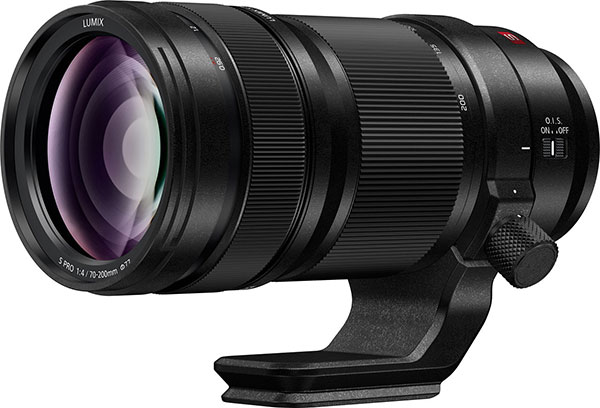Panasonic S Lenses: Hands-on with the 24-105mm f/4, 50mm f/1.4 and 70-200mm f/4 lenses
posted Tuesday, March 12, 2019 at 1:49 PM EST

Alongside a recent Panasonic shooting experience in Austin, Texas for the Lumix S1R and Lumix S1 cameras, I also had the opportunity to try out the first three of Panasonic's native L-mount lenses, the 24-105mm f/4, 50mm f/1.4 and 70-200mm f/4.
Launching a new camera system is tricky for many reasons. In Panasonic's case, because the S1 and S1R use full-frame sensors instead of the much smaller Micro Four Thirds sensors in their other Lumix interchangeable lens cameras, the S series required a new, much larger lens mount. Panasonic has employed Leica's L-Mount and alongside Leica and Sigma, created a new L-Mount Alliance. The Panasonic and Leica connection has long been present with other Panasonic cameras, so it is not a surprising match for the new S Series.
This means that in addition to the three L-Mount lenses Panasonic will release alongside their new cameras and the over ten models they promise by 2020, Sigma will be releasing lenses for the L Mount, and users can also use any of Leica's already-existing full-frame L-Mount lenses on the S1 and S1R. In fact, Sigma just recently announced that 11 of their Art Series prime lenses will be released in native L-Mount and there's a new MC adapter for coupling other EF-mount and SA-mount Sigma lenses to the S cameras.
For the time being, let's look at what Panasonic will have to offer come April, as I was able to shoot with all three launch lenses.
Lumix S 24-105mm f/4 Macro O.I.S.
The workhorse lens for many photographers, a 24-105mm zoom is a very versatile zoom which can capture images in a wide range of situations. It's a reasonably large standard zoom lens. It weighs 1.5 pounds (680 grams) and is nearly five inches (118 millimeters) long. Like the other two new Lumix S lenses launching with the camera, the 24-105mm has a 77mm filter thread. By the way, I love that each lens has the same filter thread diameter. It's really convenient and per the Panasonic team, a purposeful design choice.

The 24-105mm has Optical Image Stabilization, which means it is compatible with Panasonic's Dual I.S. 2 system. Interestingly, the 24-105mm lens can also capture 1:2 macro images thanks to its close focus distance of under a foot. Optically, the lens has 16 elements in 13 groups, including one UED element and two ED elements. There are four aspherical elements as well.

(Shot with a Panasonic S1R with Beta Firmware.)
For a standard zoom lens, the 24-105mm is pretty solid. I need further time with the lens to better evaluate its performance, especially with respect to corner sharpness, but initial impressions are positive. The lens will be available as the kit lens alongside both the S1 and S1R but will also be available separately for around $1,300 USD.
Lumix S PRO 50mm f/1.4
If you are buying the S1R and want a single lens to show off what the camera can do, the Lumix S PRO 50mm f/1.4 lens is the best choice. It has been designed for maximum image quality and is the system's benchmark lens. Held to Leica's rigorous standards and testing methodology, the 50mm f/1.4 is superbly sharp. It's a very impressive lens.

Not only is it sharp, but the out of focus area rendition is excellent as well. Bokeh is smooth and works to create a nice depth in the image. The lens features an 11-blade aperture diaphragm, which definitely helps keep things buttery smooth. Optically, the lens has 13 total elements across 11 groups. Of these 13 elements, 3 of them are Extra-Low Dispersion Elements and 2 are Aspherical Elements.

(Shot with a Panasonic S1R with Beta Firmware.)
Regarding autofocus, the lens features a Dual AF system. There are both linear and stepping motors in the lens, which delivers not only fast autofocus performance, but also very quiet autofocus.
Build quality is excellent. The lens feels really good in the hands although it is a bit heavy and rather large for 50mm f/1.4 prime. Specifically, the lens weighs 2.1 pounds (955 grams) and is 5 inches (130mm) long with a maximum diameter of 3.5 inches (90m). The lens will cost just under $2,300 USD.
Lumix S PRO 70-200mm f/4 O.I.S.
Although my time was brief with the new S PRO 70-200mm f/4 O.I.S., I was impressed by this lens. I shot some portraiture with the telephoto zoom in a dimly lit environment and it worked well in terms of autofocus, image stabilization and optical quality.

The lens has 23 elements in 17 groups, including an UED element, 3 ED elements, 1 aspherical element and 1 UHD element. All this glass adds up to a pretty high weight of 2.17 pounds (985 grams). For reference, this is about 145 grams heavier than Sony's FE 70-200mm f/4 G lens, so there's not a big difference in weight between the two lenses. I will say that the Panasonic version feels a bit better on the S Series cameras due to the camera's larger grip.
Like the 50mm f/1.4 lens, the 70-200mm f/4 PRO has a Dual AF system (linear and stepping motors), resulting in fast autofocus during my time with the lens. The OIS worked well too, not only doing a nice job with slower shutter speeds, but also keeping the viewfinder image really stable.

(Shot with a Panasonic S1R with Beta Firmware.)
Although some users will certainly be clamoring for an f/2.8 version of the 70-200mm, the f/4 version is a solid lens. It will cost $1,700 in April.